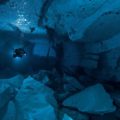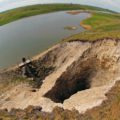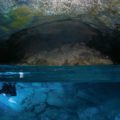- Фото: © phototeam.pro, Виктор Лягушкин
- Вид сверху на вход в пещеру. Фото: © phototeam.pro, Виктор Лягушкин
- Фото: © phototeam.pro, Виктор Лягушкин
Near the village of Orda in the Perm Krai, Russia, there is the entrance to Orda Cave, a unique natural monument. The system of passages stretches through the mass of gypsum and anhydrite for over 5 kilometers, and most of the time you would have to swim rather than walk since the cave labyrinth is almost completely under water.
For a long time, it was known only to the locals. The cave was mentioned for the first time in a research paper in 1969. However, serious studies began in the 1990s and 2000s, which included drawing the map of above-water corridors and conducting geological research, which revealed that Orda Cave is one of the oldest in the world and was formed 280–250 million years ago. It is of karstic origin. This means that water gradually dissolved the bulk of the mountain, composed of water-soluble gypsum rocks, forming an extensive network of passages and grottoes. Along with that, the dissolved rock crystallized here and there in bizarre shapes.
The entrance to the cave is a karst funnel on the southeastern side of the Kazakovskaya Mountain. It is a huge portal 5 meters wide and 2 meters high. It leads to the above-water part of the cave: the Crystal and Ice Palace grottoes. It is clear why the Ice Palace grotto got its name: it is the largest grotto of Orda Cave, its ceiling is 7 meters high, and the floor is covered with dropped ice fragments. A beautiful sight, but one should be careful while admiring it: rockfalls occur there quite regularly. In the grottoes, there are lakes leading into the underwater part of Orda Cave. For example, in the Main Lake, there is a small passage at the depth of 3 meters going downwards by 2–3 meters. It is so narrow that only one scuba diver can pass through. Water-filled galleries lead to the Dry Hall grotto, which, as its name indicates, is above the water. The path from the Dry Hall takes you to the main underwater galleries named after the hometowns of divers who explored Orda Cave during All-Russian expeditions. They are Chelyabinsk, Krasnoyarsk, Moscow, and Sverdlovsk passages. The Moscow passage is especially fascinating: it is the longest flooded tunnel in Russia and the CIS as it is 935 meters long.
There is a good reason why Orda Cave is a mecca for divers: it guarantees not only a dose of healthy adrenaline but also stunning views. White gypsum walls along with blue shades of water form a fantastic image of an unreal, fairy-tale world. It is not surprising then that in 2018 the work of photographer-diver Andrey Gorbunov Orda Cave won one of the nominations at the 4th Photo Contest The Most Beautiful Country held by the Russian Geographical Society. Filled with water, the labyrinth remains one of the few places that enable one to experience the joy of real discovery. There are still unexplored spaces that people are to find way into.
Source: uraloved.ru
Photos are courtesy of PHOTOTEAM.PRO, V.Lyagushkin, B.Vashchenko, and the authors of the book Orda Cave. Perception



